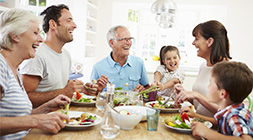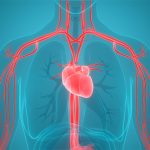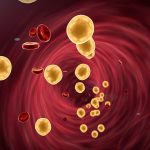
Overview
Symptoms
Causes
Prescription
Health Tips
Heart disease or cardiovascular disease (CVD) is a category of about 30 cardiovascular conditions that affect the heart or blood vessels, and which reduce blood flow to or from the heart. While some people are born with a congenital heart disease, most heart diseases develop over time due to poor diet, lifestyle choices, and genetics. Each year approximately 159,000 Canadians will be diagnosed with heart disease. Globally, it is the number one killer of both men and women, followed closely by cancer as the second leading cause of death. While men are more likely to suffer from heart disease and heart attacks, women are more likely to die from them. This may be due, in part, to women having less obvious symptoms of a heart attack. Men, on average, are affected by heart disease at a younger age (their 50’s and 60’s) than women (60’s and 70’s).
Most people believe a heart attack is signaled by arm-clutching chest pain, but women can have very different heart attack symptoms than men. Unfortunately, many women are not aware that risk of heart disease is high and do very little to protect themselves.
The five main types of CVD are:
- Coronary artery disease (atherosclerosis, or hardening of the arteries)
- Heart muscle disease (cardiomyopathy)
- Congestive heart failure (inability of the heart to pump enough blood)
- Valve disorders (mitral valve prolapse)
- Arrhythmias (heartbeat rhythm irregularities)
Atherosclerosis is the most common cause of blockage in the blood vessels and is responsible for over 40 percent of all deaths in North America. A buildup of cholesterol and fatty material, high triglycerides, injury to arteriole walls, and inflammation caused by bacteria are all implicated in the deadly narrowing of arteries. A healthier diet and lifestyle changes could reduce a large percentage of these deaths. Angina, a pain or squeezing felt in the chest, is often the result of a thickening of the arteries due to atherosclerosis, which causes a reduction in oxygen to the heart.
Symptoms
Heart disease is referred to as the ‘silent killer’ because unless one has regular checkups to monitor blood pressure and cholesterol levels, some people will not know they have a diseased heart until it is too late. Statistics published by the American Heart Association (AHA) in 2004 show that 50 percent of men and 64 percent of women who died suddenly of heart disease during the course of their study had no previous symptoms. Women often ignore the warning signs of heart disease.
Some potential symptoms of heart disease include:
- Bouts of indigestion
- Constricted feeling in the throat
- Irregular heartbeat
- Shortness of breath
Symptoms that require emergency attention include:
- Chest pain with exercise that subsides after rest
- Dizziness
- Irregular pulse
- Light-headedness or unusual fatigue
- Nausea and vomiting
- Pain or numbness in the arms, back, neck or chest
- Profuse sweating for no apparent reason (not due to menopause)
- Stomach pain
Causes
The causes of heart disease vary depending on the type of heart condition. As the intermediary between the digestive system and the immune system, a healthy cardiovascular system is integral to the body and its immunity. Often, the first sign of heart disease for some is death.
Over a century ago the medical establishment thought that heart disease was brought on by infections causing inflammation, but this theory was abandoned for what were new discoveries at the time. Now, scientists are revisiting this theory and have started researching possible links between Chlamydia pneumoniae and heart disease. This bacterium is found in high concentrations in the blood of people who have had heart attacks. The infection theory is significant in that it points to the immune system and its failure in defending the body from simple bacteria. By enhancing immunity some may be able to prevent heart disease.
The genetic risks of heart disease are still not totally clear. However, 67 different DNA variants that increase the risk of a heart attack have been discovered. The more variants a person has, the greater their risk; genetic factors may increase risk by 60 percent. It’s important to remember that a family history of heart disease does not necessarily mean genetics are involved. For many people with a family history of CVD, similar poor choices in lifestyle and dietary habits may be at the root of their heart disease. Although one may be predisposed to heart disease because of genetics, this does not mean s/he will develop it. If there is a family history of coronary heart disease (CHD) one must be vigilant in making lifestyle choices that could prevent this deadly condition.
Heart disease may actually begin in the stomach. A poor diet of packaged or processed foods high in trans-fatty acids and devoid of fiber and nutrients (especially B vitamins such as folic acid) are primary instigators of heart disease. Combine a poor diet with high stress, dehydration, aging, smoking, extra weight, and a lack of exercise or sleep and risks climb exponentially.
Diabetes, high blood pressure, high levels of harmful LDL cholesterol or high blood homocysteine levels compound the problem. Homocysteine in the blood indicates a breakdown in chemical processes in the body and is strongly linked to heart disease.
If abnormally high blood pressure (hypertension) is not treated, the heart may enlarge to pump harder against the increased pressure, causing the heart muscle to weaken and irregular heartbeat to develop. The excess burden caused by high blood pressure can also weaken or damage the artery walls, thus promoting atherosclerosis.
Diets High in ‘Bad’ Fats and Low in Fiber
Fast food, junk food, and processed foods are laden with bad fats, particularly trans-fatty acids which are toxic to the body. Margarine and hydrogenated vegetable oils raise the bad LDL cholesterol and lower the protective HDL cholesterol. Better health is achieved from consuming good fats—the essential fatty acids omega-3 and omega-6. These fatty acids help protect the body from infection, bacteria, and abnormal cell growth.
Obesity
Although North American culture is obsessed with consuming less fat, heart disease and obesity have continued to rise. Just being overweight works against overall health and increases risk of heart disease. Scientists have observed that where one carries the weight may be more important in determining risk of heart disease. Pear-shaped bodies carry the bulk of the weight in the hips and thighs, whereas apple-shaped bodies hold the weight in front of the stomach. The excess stores of fat around the stomach are associated with an increased risk of high cholesterol, high blood pressure, type 2 diabetes, and resistance to insulin—all factors that increase the risk of heart disease.
Sedentary Lifestyle
Those who follow a sedentary lifestyle may get much more than a body that is out of shape. If physical exercise is entirely ignored heart rate increases and one may suffer the risks of stroke, high cholesterol, high blood pressure, diabetes, depression, obesity, osteoporosis, or other illness.
Smoking/Vaping
Heart disease is the leading cause of death in people who smoke tobacco and other substances. Smokers are less likely to survive heart attacks than non-smokers. Smoking marijuana or the nicotine in tobacco both contribute to hypertension by increasing the heart rate of smokers or in those consuming cannabis or nicotine (edible/drinkable cannabis products, chewing tobacco). The heart will then require more oxygen, while at the same time the blood’s capacity for carrying oxygen is lowered by the carbon monoxide in the tobacco/marijuana smoke. In addition, smoking also squeezes the arteries, further reducing the blood supply to the oxygen-hungry heart. In a nutshell, smoking tobacco or marijuana forces the heart to work harder with less oxygen. When people experience angina pectoris (chest pain), it is because the heart’s blood supply has been restricted.
Unfortunately, non-smokers are also at risk if they socialize or are near smokers and ‘tokers’ because they are exposed to the second-hand smoke. Smoke from the lit end of the cigarette is not filtered and contains twice as much tar and nicotine, five times as much carbon monoxide, and over 4000 chemicals—50 of which have been labeled true carcinogens (meaning cancer causing). Smoke from the lit end of a joint also contains tar, carbon monoxide and other toxic chemicals such as nitric oxide, ammonia and hydrogen cyanide. Some of these are in higher concentrations than in tobacco smoke.
Many people now choose to smoke e-cigarettes, or ‘vape’ tobacco and other products but recent research has shown that vaping carries the same or similar risks as smoking.
Diabetes
According to North American diabetes associations, diabetics have a threefold risk of premature death due to atherosclerosis. In diabetics an elevated insulin level may damage certain receptors for the bad LDL cholesterol and, as a result, the feedback system that stops cholesterol from being produced when it is no longer needed is impaired. The resultant excess LDL cholesterol promotes hardening of the arteries.
Diabetics have also been found to have very low levels of dehydroepiandrosterone (DHEA), the immune and anti-aging hormone. Physicians know that people with low levels of DHEA have higher rates of arteriosclerosis. In a study published in the International Journal of Sports Medicine, researchers reported that participants taking plant sterols and sterolins had an increase in DHEA and a decrease in cortisol. Scientists believe that plant sterols and sterolins may be used by the body to make DHEA, thereby providing protection from hardening of the arteries. As well, when cortisol, the stress hormone, is high, DHEA levels drop promoting clogged arteries.
Prescription Medication
Statin drugs are often prescribed by doctors to lower levels of blood cholesterol. However, statins reduce the body’s production of coenzyme Q10. Coenzyme Q10 (aka CoQ10 or ubiquinone) is essential for energy production for heart muscle, so a deficiency in coenzyme Q10 increases the risk of heart attack. Statin drugs also increase the need for vitamins A, D, and E, and they have been implicated in increasing risk for cataracts.
Low Levels of Antioxidants, Essential Fats, and Minerals
Nutrient deficiencies are common in people who experience heart failure. Low levels of magnesium, zinc, selenium, vitamin D and essential fatty acids are all recorded examples. Consuming a diet high in antioxidants foods (fruits, vegetables, whole grains) has been shown to reduce the risk of heart disease. Antioxidants help protect the heart from oxidative stress caused by smoking, stress, exercise, pollution, and consuming processed foods or rancid fats. Oxidative stress increases LDL, the ‘bad’ cholesterol. A diet low in magnesium can also cause LDL levels to rise as magnesium assists in the metabolism of cholesterol. Magnesium helps to prevent blood clots, increases the heart’s oxygen supply, and reduces triglyceride levels.
Bad fats such as trans-fats, fats from fried foods, and rancid fats may all cause damage to blood vessels by causing inflammation. Omega-3 fatty acids protect the heart and help to reduce inflammation, as well as decrease triglycerides.
Tension, Stress, and Personality Type
Early studies on the connection between heart disease and Type A personality found that these people have a predisposition to heart attacks. Later research discovered that it is not having a Type A personality, but particularly negative elements of that behavior that trigger an increased risk of heart disease. The research described Type A people as high achievers who are very aware of time, they work hard, and hate standing in lines, but it was the associated feelings of hostility, distrust, and anger that affected their susceptibility to heart disease.
People who dwell on the negative or who are under stress all the time overwork their nervous system by constantly secreting hormones like cortisol, epinephrine, and norepinephrine. These are the same stress hormones that are released when someone perceives s/he is in mortal danger and must decide to fight or run away. These hormones can damage the body when secreted continually. Elevated blood pressure, suppressed immunity, osteoporosis, rapid aging, and heart disease are some of the diseases associated with higher-than-normal cortisol levels.
Excessively Sticky Platelets
Excessively sticky platelets promote heart disease and stroke. Platelets become a problem when trans-fatty acids and processed oils, margarine, and spreads are consumed. By adding omega-3 fats from flax and fish to the diet one can reduce the stickiness of platelets and prevent heart disease. Garlic has also been shown to reduce sticky platelets; one aspect of its powerful heart protective ability.
High Levels of Homocysteine
Scientists believe that elevated homocysteine levels may promote heart disease by damaging artery walls. Homocysteine is produced by the body during the conversion of certain amino acids. Without adequate levels of vitamins B12, B6, and folic acid, homocysteine levels can become dangerously elevated. A high homocysteine level is a risk factor for heart attack, stroke, and osteoporosis. It also contributes to atherosclerosis by damaging artery walls and disrupting collagen formation (collagen disruption also results in poor bone development, an increased risk factor for osteoporosis). Almost 40 percent of patients with heart disease will have elevated homocysteine levels. By simply taking a high potency B-complex supplement containing 400 mcg of folic acid with 50 mg of vitamin B6 and 500 mcg of vitamin B12, homocysteine levels will normalize, thus reducing the risk of heart attack, stroke, and atherosclerosis. A vitamin B-complex daily is also essential for protecting against osteoporosis.
Prescription for Health
Although heart disease is a leading killer, there is an upside. Heart disease is preventable — and reversible. Like other progressive diseases such as diabetes and cancer, it doesn’t have to result in millions of patients who clutter hospitals, fill drug prescriptions and require expensive operations. Diet, lifestyle, exercise and supplements can all help. Reversing it requires a commitment to the recommendations given below.
Diet
Heart disease may be prevented by including certain foods in the diet and avoiding others.
Include:
- Beans, lean organic meats, organic eggs
- Fish; particularly anchovies, mackerel, wild salmon, sardines
- Fruits and vegetables; aim for 8 to 10 servings a day
- Healthy fats; borage, avocado, or extra-virgin olive oil, organic grass-fed butter, fish oil
- Whole grains; millet, buckwheat, amaranth, quinoa
Avoid:
- Deli meats, processed meats
- Fast foods
- Rancid fats, trans-fat foods, fried foods
- Sugar and artificial sweeteners
- White, processed carbohydrates (white rice, white bread, pastas)
Lifestyle & Exercise
Regular exercise, especially aerobic activity, combats heart disease on many levels. Exercise burns fat which helps to maintain or reduce weight, improve blood circulation and provide more oxygen to the heart; and exercise helps relieve stress by reducing tension in the body. For people who have been diagnosed with borderline hypertension, studies have shown that regular exercise can return blood pressure to normal. Other research has indicated that exercise improves insulin sensitivity for several hours afterwards.
Yoga and tai chi are highly recommended because they double as exercise and as emotional stress-reducers. It is important to move the body to get blood flowing and keep the heart pumping healthfully. If one is sedentary, begin an exercise program even if that is just walking fifteen to thirty minutes per day.
An adjustment in attitude is imperative in reducing the risk of heart disease. When events occur that may cause a negative emotional spiral, stop those thoughts and make a mental note of the positive aspects. Often, there are positive outcomes from what are, at first, negative occurrences. Keep a running list of these positive possibilities in mind until the negativity goes away. This may take days or weeks of conscious effort for some but worth the reward to one’s cardiovascular health. Practicing meditation is very effective at reducing stress and emotional negativity.
Supplements
Related to diet is nutritional supplementation. Is supplementing really necessary? The answer is a resounding yes. Specific nutrients have been shown to have a markedly beneficial effect on ailing hearts, high cholesterol and blood pressure. Even late-stage heart disease and post-surgery conditions can benefit from vitamins, minerals and nutrients.
If one is currently on the anti-coagulant drug warfarin/Coumadin, or is currently taking medications for high cholesterol or high blood pressure, speak to the physician or pharmacist about drug-nutrient interactions. Be aware that both high blood pressure and high cholesterol medications cause depletion of coenzyme Q10, so it is recommended to supplement with CoQ10 to ensure adequate levels.
According to the Drug-Induced Nutrient Depletion Handbook for Pharmacists, if taking Lasix (furosemide) be aware that Lasix depletes calcium, magnesium, potassium, vitamins B1, B6, and C, and zinc. These nutrients must be replaced in the diet or with supplements to prevent deficiency. If one has high blood pressure, high cholesterol, or heart palpitations, there are specific treatment recommendations for each.
| Nutrient | Action | Dosage |
|---|---|---|
| Elemental magnesium (bisglycinate) |
200-400 mg | Alleviates arrhythmias, heart palpitations; essential for proper heart muscle function; supports healthy blood pressure; improves blood flow; reduces fatty plaques |
| Coenzyme fully reacted B-complex: | Look for a minimum of the following per daily dose:
B1 – 100 mg B2 – 7.5 mg Niacin – 353 mg B5 – 300 mg B6 – 100 mg B12 – 1000 mcg Folate – 1000 mcg |
B vitamins (normalize homocysteine, reduce stress), reduces risk of heart disease, stroke, and atherosclerosis |
| Vitamin E | 400-800 IU | Reduces risk of heart attacks |
| Vitamin C with bioflavonoids | 1000 mg twice a day; with bioflavonoids 100 mg daily | Reduces symptoms and risk of heart disease; antioxidant, which raises HDL (good) cholesterol and lowers blood pressure |
| Coenzyme Q10 | 100 to 300 mg daily | Potent antioxidant, boosts energy production in the heart muscle; significantly extends life in those with congestive heart failure |
| Inositol Hexanicotinate (Non-flushing niacin) |
500–1000 mg three times daily with meals | Lowers LDL cholesterol and triglycerides while raising HDL cholesterol
Have liver enzymes and cholesterol checked every three months |
| Hawthorn Extract (standardized 1.8% vitexin or 10% procyanidin content) |
100–200 mg three times daily | Double-blind studies show improvement in those with congestive heart failure |
| Garlic | 2000–4000 mg | Improves circulation, shown to reduce blood pressure |
| Pycnogenol | 100 mg twice daily | Reduces platelet aggregation |
| Omega-3 Fatty Acids | 2 to 4 grams per day | Reduces risk of heart disease; lowers triglycerides |
Health Tips to Enhance Healing
- Consume a diet emphasizing fresh fruits and vegetables, whole grains, legumes, lean meats and fish to lower the risk of heart disease. Eat plenty of fresh-pressed garlic to help lower blood pressure.
- Consume more fatty fishes which contain EPA, DHA, and omega-3 essential fatty acids. The American Heart Association (AHA) recommends two servings of fish per week to prevent heart disease. Alternatively, be sure to supplement with essential fatty acids to lower triglyceride levels and support normal cardiovascular health.
- Exercise. Walking just 30 minutes three times per week cuts risk of heart attack by about 30 percent. The more energetic the exercise, the greater the benefit: increase the walking pace by two miles per hour or faster to reduce cardiovascular disease risk by up to 63 percent.
- Have thyroid hormone levels checked. Low levels of thyroid hormone cause heart palpitations in women and add to heart stress.
- Insist on having homocysteine and C-reactive protein levels (both indicators of heart disease) checked by a physician. High levels can be quickly addressed by supplementing with magnesium, B6, B12, folic acid and fish oils.
- Quit smoking/vaping and avoid second-hand smoke.
- Reduce consumption of salt, caffeine and alcohol and be sure to get plenty of exercise followed by sufficient rest.
- Reduce sodium intake by avoiding table salt and processed foods. Increase intake of potassium-rich foods such as bananas, apricots, tomatoes, avocados, potatoes, lean skinless chicken and fresh fish.
- Relax. Holding on to anger and other negative emotions is not only bad for mental health, it is also linked to increased risk of heart disease.
- Stay hydrated with adequate amounts of pure, filtered water to maintain blood flow. Studies show drinking five glasses of water per day cuts risk of stroke and heart attack in half.














